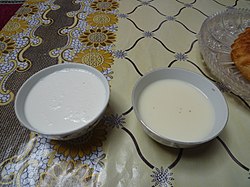 Bowls of shubat (left), beverage of fermented camel milk, and kumis (right), beverage made from fermented mare's milk | |
| Alternative names | Shubat |
|---|---|
| Place of origin | Turkmenistan, Uzbekistan and Kazakhstan |
| Main ingredients | Camel milk |
Chal, also shubat or khoormog (Kazakh: шұбат, şūbat, pronounced [ʂo̙bɑt], Mongolian: хоормог, khoormog, pronounced [χɔ̙ːrmɞ̙k]), is a Turkic (especially Turkmen, Uzbek and Kazakh) and Mongolic beverage of fermented camel milk, sparkling white with a sour flavor, popular in Central Asia — particularly in Kazakhstan, Uzbekistan and Turkmenistan.[1][2] In Kazakhstan the drink is known as shubat, and is a staple summer food.[3] Due to preparation requirements and perishable nature, chal has proved difficult to export.[4] Agaran (fermented cream) is collected from the surface of chal.[5]
Description
[edit]Fermented chal is reputed to possess virucidal and virus inhibiting properties[citation needed] not found in fresh camel or cow milk, both in its liquid and lyophilized form — a characteristic which is (reputedly) unaffected by shelf life.
Chal is typically prepared by first souring camel milk in a skin bag or ceramic jar by adding previously soured milk. For 3–4 days, fresh milk is mixed in; the matured chal will consist of one third to one fifth previously soured milk.[6]
Camel milk will not sour for up to 72 hours at temperatures below 10 °C (50 °F). At 30 °C (86 °F) the milk sours in approximately 8 hours (compared to cow's milk, which sours within 3 hours).
A comparison of the composition of camel milk and camel chal:[7]
| Camel milk | “Chal” | |
|---|---|---|
| acidity | 18°D | 28°D |
| fat | 4.3% | 4.3% |
| lactose | 2.75% | 1.32% |
| non-fat solids | 8.2% | 6.6% |
| ash | 0.86% | 0.75% |
| ethyl alcohol | 1.1% | |
| ascorbic acid | 5.6 mg% | 4.8 mg% |
Dornic acidic degrees are used to describe acidity in milk products, with 1 Dornic degree (1°D) equal to 0.1g of lactic acid per liter.[8] The chal contained Lactobacilli lactic; streptococci and yeast.[9]
Chal may be cultured with lactobacillus casei, streptococcus thermophilus, and lactose-fermenting yeasts incubating in inoculated milk for 8 hours at 25 °C (77 °F), and then subsequently for 16 hours at 20 °C (68 °F). Holder pasteurization does not affect the quality of the milk, but pasteurization at higher temperatures (85 °C/185 °F) for 5 minutes negatively impacts flavour. Chal made from pure cultures of lactobacillus casei, streptococcus thermophilus, and species of torula has markedly less not-fat solids and lactose than the milk from which it is made.[10]
See also
[edit]References
[edit]- ^ Anatoly Michailovich Khazanov (15 May 1994). Nomads and the outside world (2nd ed.). Univ of Wisconsin Press. p. 49. ISBN 978-0-299-14284-1.
- ^ Alhadrami, G.A.; Faye, Bernard (2016). "Animals that produce dairy foods: Camel". Reference module in food sciences. Elsevier.
- ^ Aliya Meldebekova; Gaukhar Konuspayeva; Emilie Diacono; Bernard Faye (2008). "Heavy Metals and Trace Elements Content in Camel Milk and Shubat from Kazakhstan". In Yuriy Sinyavskiy; Bernard Faye (eds.). Impact of Pollution on Animal Products (NATO Science for Peace and Security Series C: Environmental Security). Berlin: Springer. pp. 117–123. doi:10.1007/978-1-4020-8359-4. ISBN 978-1-4020-8357-0.
- ^ "Great Culinary Dictionary. Chal in Russian, retrieved April 11, 2007". Archived from the original on October 13, 2007. Retrieved April 11, 2007.
- ^ I.Barkhanov. Neutral Turkmenistan newspaper, in Russian, August 9, 2001 Archived November 10, 2005, at the Wayback Machine.
- ^ Prof Zafar Iqbal Chaudhary & Dr Shahan Azeem, Is camel milk good for human health? DAWN Sci-tech world, October 9, 2004 Archived September 27, 2007, at the Wayback Machine.
- ^ Grigoryants, N.N. (1954). "Composition of camel milk and chal". Vop. Pit. (in Russian). 13: 41–5.
- ^ http://www.idfdairynutrition.org/Files/media/Glossary_documents_PDF/ENG/L/Lex_EN_-_lactic_acid_071226-2008-00159.pdf [bare URL PDF]
- ^ Kieselev, N. (1956). "Bacteriological examination of chal". Mol. Prom. (in Russian). 17: 31–4.
- ^ Kuliev, K. (1959). "The utilisation of camels' milk". Mol. Promyslenn. 20 (28).
cited in R. Yagil (1982). Camels and Camel milk. FAO animal production and health paper. Rome: Food and Agriculture Organization of the United Nations (FAO). ISBN 92-5-101169-9.
External links
[edit]- Brigor'iants NN (1954). "[Chemical composition of chal (fermented camel's milk)]". Vopr Pitan (in Russian). 13 (4): 41–2. PMID 13187930.
- Konuspayeva G, Faye B, Loiseau G, Levieux D (January 2007). "Lactoferrin and immunoglobulin contents in camel's milk (Camelus bactrianus, Camelus dromedarius, and Hybrids) from Kazakhstan". J. Dairy Sci. 90 (1): 38–46. doi:10.3168/jds.S0022-0302(07)72606-1. PMID 17183073.
- Martinenko, N.l.; Yagodinskaya, S.G.; Adhundov, A.A.; Charyev, K.C. & Khumedov, O. (1977). "Content of trace elements, copper, manganese, molybdenum in culture of chal and camel's milk and their clinical significance". Dairy Sci. Abst. 40 (7802): 824. Archived from the original on 2011-05-25. Retrieved 2007-04-06.
- Palmated Esenov; Bernard Faye, eds. (2005). Desertification Combat and Food Safety: The Added Value of Camel Producers (PDF). Amsterdam: IOS Press. ISBN 1-58603-473-1. Archived from the original (PDF) on 2007-09-28. Retrieved 2007-04-06.
- Filip Noubel, "Golden Century of the Turkmens:" A Bleak Picture of Village Life in the Desert. EurasiaNet photo essay, 10/25/02
